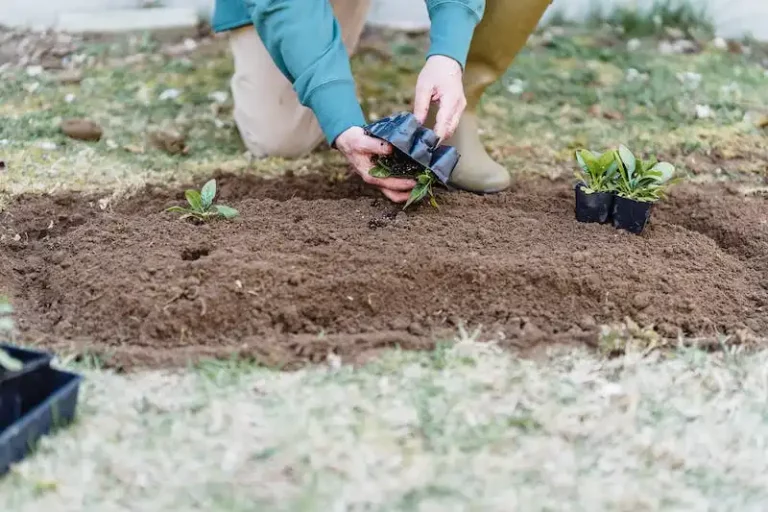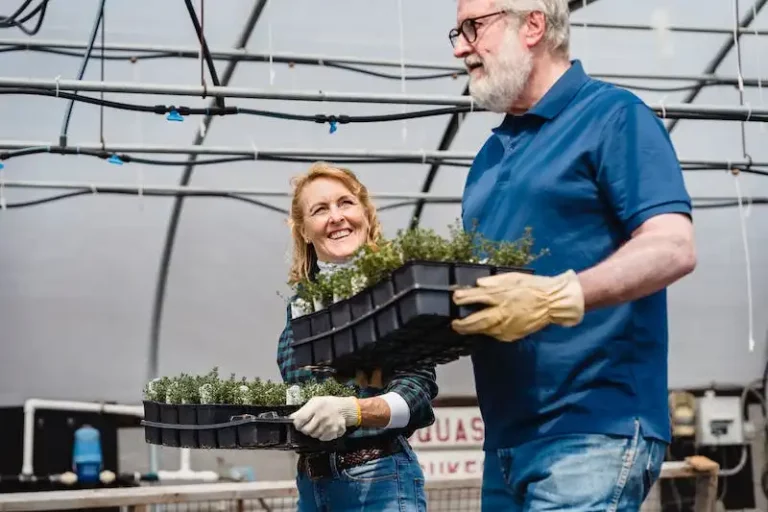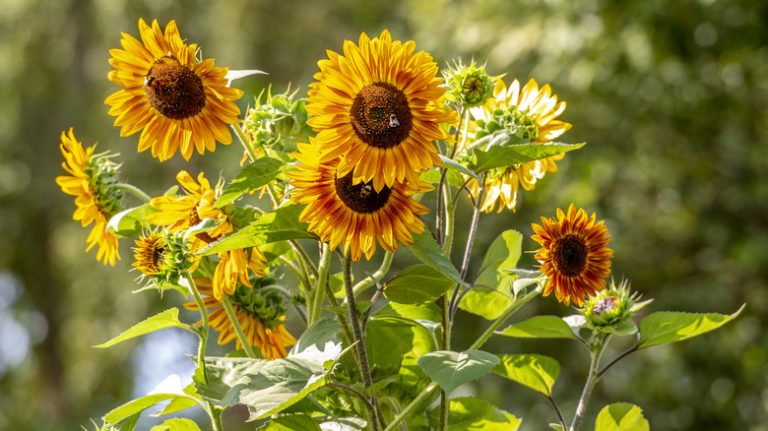The Verbena flower is an annual plant that is perfect for every garden. With its heat-tolerant and upright growing habit, it is a proven winner in any garden setting. This va-va-voom plant is frequently asked about, and for good reason – its lemon, purple, and plum color is simply stunning. Whether planted in containers or in the ground, the Verbena will provide a mass of beautiful flowers throughout the growing season.
When caring for Verbena, it is important to provide well-drained soil. This herb will tolerate a wide range of soil types as long as they are well drained. Planting in a sunny location is ideal as the Verbena thrives in full sun. It can tolerate some shade, but the flowering may be somewhat reduced. During the growing season, it is a good idea to fertilize every 4-6 weeks to keep the plant in peak condition. Shearing back the plant occasionally will help to promote more flowering.
One of the great things about the Verbena flower is its ability to attract butterflies, bees, and hummingbirds. This makes it a perfect addition to any butterfly or hummingbird garden. Another great aspect of Verbena is that it is deer resistant, so you won’t have to worry about these animals eating your plants. If you have issues with rabbits, Verbena is a great choice as well, as they typically do not bother this plant.
For those who are obsessed with Verbena, there is a superbena® series of plants available. These plants are known for their superb vigor and continuous blooming. They are perfect for creating a colorful and vibrant display in your garden or containers. The superbena® series comes in various colors such as pink, purple, and violet, allowing you to choose the perfect one for your garden.
Whether you are a beginner gardener or an experienced one, Verbena flowers are a great choice for your garden. With its beautiful flowers, heat tolerance, and easy care, it is a plant that will bring joy and beauty to any garden. So go ahead and plant some Verbena seeds or get a container-grown plant to start enjoying this superb flower today!
FAQ’s about Verbena:
Q: Is Verbena a perennial or an annual plant?
A: Verbena is an annual plant that needs to be replanted each year.
Q: Can Verbena tolerate heat?
A: Yes, Verbena is heat-tolerant and thrives in full sun.
Q: How often should I fertilize Verbena?
A: Fertilize every 4-6 weeks throughout the growing season.
Q: Does Verbena attract butterflies and hummingbirds?
A: Yes, Verbena is known for attracting butterflies, bees, and hummingbirds.
Q: What colors does the superbena® series come in?
A: The superbena® series comes in various colors including pink, purple, and violet.
Q: Is Verbena deer resistant?
A: Yes, Verbena is deer resistant and typically not bothered by rabbits.
Q: Can Verbena be grown in containers?
A: Yes, Verbena is a great choice for container-grown plantings.
Q: Can Verbena be grown from seeds?
A: Yes, Verbena can be grown from seeds, but it is easier to start with a plant.
Q: Does Verbena require deadheading for continuous flowering?
A: No, Verbena will continue to flower without deadheading, but removing spent flowers can neaten its appearance.
Source: https://example.com/verbena-flower
Verbena Seeds
When it comes to growing verbena flowers, starting from seeds is a cost-effective and rewarding option. Verbena seeds can be easily purchased from gardening centers or online shops. They come in a wide variety of colors and types, including annual and perennial verbenas.
The characteristics of different verbenas can vary, but most verbena seeds prefer well-drained soil and full sunlight. They are known for their spreading and trailing growth habit, making them perfect for ground cover or hanging baskets. The foliage of verbena plants can range from green to plum colors, adding visual interest to any garden.
Before planting verbena seeds, it is important to prepare the soil properly. Make sure the soil is loose, fertile, and somewhat moist. Verbena seeds should be planted in flats or trays indoors, about 10-12 weeks before the last frost date. Use a seed starting mix and plant the seeds about 1/4 inch deep. Keep the soil consistently moist by watering from below.
Once the seeds have germinated and the danger of frost has passed, the verbena seedlings can be transplanted outdoors. Choose a location with well-drained soil and plenty of sunlight. If growing verbena in containers, make sure they have good drainage. Verbena plants can tolerate somewhat dry conditions, but they will perform best with regular watering.
To care for verbena plants, deadhead them frequently to encourage continuous blooming. Deadheading is the process of removing the faded flowers to promote new growth and prevent the plant from going to seed. This will keep the plant looking tidy and in full bloom throughout the season.
Fertilizing verbena plants is not necessary, but it can help promote healthy growth and abundant flowering. Use a slow-release fertilizer according to the manufacturer’s instructions. Over-fertilizing can result in excessive foliage growth at the expense of flowering. Apply the fertilizer once at the beginning of the growing season for best results.
One of the characteristics of verbena plants is their ability to reseed themselves. This means that if you let the flowers go to seed, new verbena plants may sprout up in the following year. If you want to prevent this, simply remove the spent flowers before they set seed. However, if you enjoy having verbena plants reseed, leave some flowers on the plants towards the end of the growing season.
Verbena is a popular choice for attracting butterflies, bees, and other beneficial insects to the garden. It also makes a great companion plant for vegetables and other flowering plants. Its heat-tolerant nature and long flowering season make it a favorite among gardeners.
When it comes time to harvest verbena seeds, look for dried seed heads on the plants. Once the seed heads are dry and crispy, they can be collected. Gently rub the seed heads to release the seeds into a zip-lock bag or a container. Store the seeds in a cool, dry place until you are ready to plant them next year.
Whether you are a beginner or a seasoned gardener, verbena seeds are a great addition to any garden. They are easy to grow, low-maintenance, and provide a splash of color throughout the growing season.
Obsession Twister Series
The Obsession Twister Series includes a variety of Verbena flowers that are perfect for adding vibrant color and texture to your garden. These annuals are heat-tolerant and grow well in full sun, making them ideal for use in massed plantings or as a stand-alone statement plant.
The Verbena ‘Obsession Twister Series’ features outstanding branching and mounding habits with a spreading or trailing growth pattern. The plants tolerate heat and humidity, making them perfect for gardens located in warmer climates or regions with long, hot summers.
Caring for the Obsession Twister Series is quite easy. These Verbena varieties are low-maintenance and frequently reseed themselves. They tolerate drought and thrive in well-drained soil. To ensure fuller growth and more flowers, it is recommended to trim them back before and during the growing season.
This Verbena series offers a wide range of colors, including pink, plum, blue, and lemon, which provide an ultimate va-va-voom for your garden. The Obsession Twister Series also includes the Verbena x hybrida ‘Superbena’ and ‘Tapien®’ types, which are known for their outstanding performance and versatility.
Whether you choose to grow these Verbena flowers in flower beds, containers, or hanging baskets, they will surely add a touch of beauty to any space. The Obsession Twister Series is also deer-resistant, making it a great option for gardens where deer may be a concern.
To care for these Verbena flowers, provide them with enough sunlight, water, and well-drained soil. They can tolerate some moisture, but it is important to not overwater them. Trim them back if needed to maintain a tidy appearance and encourage continuous blooming.
Grown as annuals, the Obsession Twister Series will flower throughout the summer and into the fall. If you want to enjoy these beautiful flowers again next year, you can collect the seeds or try transplanting them to a protected window area during the winter months.
With their vibrant colors, long flowering period, and easy care requirements, the Obsession Twister Series is a fantastic choice for any gardener looking to add a pop of color and interest to their outdoor space.
Verbena x hybrida
Verbena x hybrida, commonly known as verbena, is a popular and versatile annual flower. Its vibrant colors and lush foliage make it a beautiful addition to any garden or landscape.
Verbena x hybrida is a cross between two other types of verbena, resulting in a plant that combines the best characteristics of both. The flowers are fuller and bloom in a wider range of colors than other types of verbena. The foliage is also more robust, providing a lush backdrop for the vibrant blooms.
Verbena x hybrida is grown as an annual, meaning it completes its lifecycle in one season. It is perfect for planting in the front or back of flower beds, as it can spread and create a full, colorful display.
These long-blooming plants prefer full sun but can tolerate some shade. They are also heat tolerant and can withstand dry conditions once established. Verbena x hybrida is relatively low-maintenance, requiring only regular watering and occasional deadheading to prolong the blooming period.
Verbena x hybrida comes in a wide range of colors, including pink, purple, red, and white. It can be grown from seeds or purchased as plants. If growing from seeds, it is recommended to start them indoors about 8-10 weeks before the last frost date.
When planting verbena x hybrida, be sure to space them about 12-18 inches apart to allow for their spread. They also pair well with other annuals and perennials, creating a bold and colorful combination.
Common questions about caring for verbena x hybrida include how to fertilize, how much water is needed, and what type of sunlight it prefers. The basics of caring for verbena x hybrida are to provide it with full sun, regular watering to keep the soil evenly moist, and occasional fertilizing to promote healthy growth.
Verbena x hybrida is generally pest and disease resistant, but it may attract aphids or rabbits in certain conditions. If these pests become a problem, there are various organic and chemical control options available.
Verbena x hybrida, with its va-va-voom colors and long-blooming season, is an obsession for many gardeners. Its easy and carefree nature, coupled with its vibrant and bold flowers, make it a must-have for any garden. Whether planted in beds, borders, containers, or hanging baskets, verbena x hybrida is sure to bring a splash of color and beauty to any space.
For more information and tips on growing and caring for verbena x hybrida, check out our FAQ’s section or download our planting guide.



